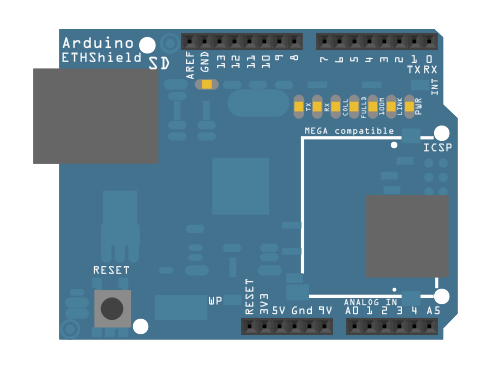Learning Examples | Foundations | Hacking | Links
Examples > SD DumpFile
Using the SD library to retrieve information over a serial port
This example shows how to read a file from a SD card using the SD library and send it over the serial port. Please click here for more information on the SD library.
Hardware Required
- Arduino board
- Ethernet Shield (or other board with an SD slot)
- Formatted SD card with a file named "datalog.txt" containing some text
Circuit
image developed using Fritzing. For more circuit examples, see the Fritzing project page
None, but the Arduino has to have the Ethernet Shield and a USB cable connected to the computer.
Code
The code below is configured for use with an Ethernet shield, which has an onboard SD slot. In the setup(), call SD.begin(), naming pin 4 as the CS pin. This pin varies depending on the make of shield or board you are using.
On the SD card, there is a file named "datalog.txt". In the loop(), the file is opened when calling SD.open(). To send the file serially to a computer, use Serial.print(), reading the contents of the file with SD.read().
SD card file dump
This example shows how to read a file from the SD card using the
SD library and send it over the serial port.
The circuit:
* SD card attached to SPI bus as follows:
** MOSI - pin 11
** MISO - pin 12
** CLK - pin 13
** CS - pin 4
created 22 December 2010
This example code is in the public domain.
*/
#include <SD.h>
// On the Ethernet Shield, CS is pin 4. Note that even if it's not
// used as the CS pin, the hardware CS pin (10 on most Arduino boards,
// 53 on the Mega) must be left as an output or the SD library
// functions will not work.
const int chipSelect = 4;
void setup()
{
Serial.begin(9600);
Serial.print("Initializing SD card...");
// make sure that the default chip select pin is set to
// output, even if you don't use it:
pinMode(10, OUTPUT);
// see if the card is present and can be initialized:
if (!SD.begin(chipSelect)) {
Serial.println("Card failed, or not present");
// don't do anything more:
return;
}
Serial.println("card initialized.");
// open the file. note that only one file can be open at a time,
// so you have to close this one before opening another.
File dataFile = SD.open("datalog.txt");
// if the file is available, write to it:
if (dataFile) {
while (dataFile.available()) {
Serial.write(dataFile.read());
}
dataFile.close();
}
// if the file isn't open, pop up an error:
else {
Serial.println("error opening datalog.txt");
}
}
void loop()
{
}
